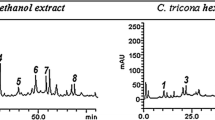Abstract
The aim of this study was to investigate the mutagenic and antimutagenic effects of Ecballium elaterium (EE) fruit juice, which has an anti-inflammatory effect, using in vitro human peripheral lymphocytes. To investigate the mutagenic effects of the EE fruit juice, human peripheral lymphocytes were treated with three doses (18, 36, and 72 μl/l) of fruit juice alone for 24 and 48 h. For investigating the antimutagenic effects of the EE fruit juice, the human lymphocytes were also treated with the mixture of the fruit juice and 0.25 μg/ml MMC. The EE fruit juice induced the percentage of total CA when used alone (especially the percentage of structural CA than the percentage of the numerical CA) and synergically induced the percentage of total CA when used as a mixture with MMC. The EE fruit juice did not affect the SCE frequency for 24 and 48 h treatment time. In contrast, EE and MMC as a mixture sinergically induced the SCE frequency at the highest concentration for 48 h treatment time only. EE alone did not decrease the RI while it decreased the MI in a dose-dependent manner. EE and MMC as a mixture have a higher cytotoxic effect than the cytotoxic effects of EE alone. As a result, it can be concluded that EE had no antimutagenic effect while EE had a mutagenic and a cytotoxic effect in human peripheral lymphocytes.
Similar content being viewed by others
References
Toker, G., Memisoglu, M., Toker, M.C., and Yesilada, E., Callus Formation and Cucurbitacin B Accumulation in Ecballum elaterium Callus, Fitoterapia, 2003, vol. 74, nos. 7–8, pp. 618–623.
Baytop, T., Therapy with Medical Plants in Turkey, Nobel Medical Publ., 1999.
Yesilada, E., Tanaka, S., Sezik, E., and Tabata, M., Isolation of an Anti-Inflammatory Principle from the Fruit Juice of Ecballium elaterium, J. Nat. Prod., 1988, vol. 51, no. 3, pp. 504–850.
Uslu, C., Karasen, R.M., Sahin, F., et al., Effect of Aqueous Extracts of Ecballium elaterium Rich. in the Rabbit Model of Rhinosinusitis, Int. J. Pediatric Otorhinolaryngol., 2005 (in press).
Eray, O., Tuncok, Y., Eray, E., et al., Severe Uvular Angioedema Caused by Intranasal Administration of Ecballium elaterium, Vet. Hum. Toxicol., 1999, vol. 41, no. 6, pp. 376–378.
Satar, S., Gokel, Y., Toprak, N., and Sebe, A., Life-Threatening Uvular Angioedema Caused by Ecballium elaterium, Eur. J. Emerg. Med., 2001, vol. 8, no. 4, pp. 337–339.
Caiozzi, G., Cabrera, D., Mardonez, J.M., and Saldias, F., Herbal Medicines and Severe Adverse Effects: Uvular Angioedema Caused by Ecballium elaterium, Rev. Med. Chil., 2002, vol. 130, no. 12, pp. 1407–1410.
Koussidis, G.A., Mountantonakis, S., and Petrichou, C.C., Folk Remedies Still in Use: A Case of Soft Palate and Uvular Oedema Due to Ecballium elaterium, Int. J. Clin. Pract., 2002, vol. 56, no. 10, p. 817.
Yesilada, E., Tanaka, S., Tabata, M., and Sezik, E., Anti-Inflammatory Effects of the Fruit Juice of Ecballium elaterium on Edemas in Mice, Phytother. Res., 1989, vol. 3, no. 2, pp. 75–76.
Agil, A., Miro, M., Jimenez, J., et al., Isolation of an Anti-Hepatotoxic Principle from the Juice of Ecballium elaterium, Planta Medica, 1999, vol. 65, no. 7, pp. 673–675.
Basaran, A.A., Yu, T.W., Plewa, M.J., and Anderson, D., An Investigation of Some Turkish Herbal Medicines in Salmonella typhimurium and in the COMET Assay in Human Lymphocytes, Teratog. Carcinog. Mutagen., 1996, vol. 16, no. 2, pp. 125–138.
Evans, H.J., Human Peripheral Blood Lymphocytes for the Analysis of Chromosome Aberrations in Mutagen Tests, Handbook of Mutagenicity Test Procedures, Kilbey, B.J., Legator, M., Nichols, W., and Ramel, C., Eds., Elsevier Sci., BV., 1984, 2nd ed., pp. 405–427.
Perry, P.E. and Thompson, E.J., The Methodology of Sister Chromatid Exchanges, Handbook of Mutagenicity Test Procedures, Kilbey, B.J., Legator, M., Nichols, W., and Ramel, C., Eds., Elsevier Sci., BV., 1984, 2nd ed., pp. 495–529.
Albertini, R.J., Anderson, D., Douglas, G.R., et al., IPCS Guidelines for the Monitoring of Genotoxic Effects of Carcinogens in Humans, Mutat. Res., 2000, vol. 463, pp. 111–172.
Speit, G. and Haupter, S., On the Mechanisms of Differential Giemsa Staining of Bromodeoxyuridine-Substituted Chromosomes. II. Differences between the Demonstration of Sister Chromatid Differentiation and Replication Patterns, Hum. Genet., 1985, vol. 70, pp. 126–129.
Roncada, T., Vicentini, V.E., and Mantovani, M.S., Possible Modulating Actions of Plant Extracts on the Chromosome Breaking Activity of MMC and Ara-C in Human lymphocytes in Vitro, Toxicol. in Vitro, 2004, vol. 18, pp. 617–622.
Mendelsohn, M.L., Antimutagenic Effects in Humans, Mutat. Res. Fundamental Mol. Mechanisms Mutagen., 1992, vol. 267, pp. 257–264.
Paz-y-Miño, C., Bustamante, G., Sánchez, M. E., and Leone, P. E., Cytogenetic Monitoring in a Population Occupationally Exposed to Pesticides in Ecuador, Environ. Health Perspective, 2002, vol. 110, no. 1, pp. 1077–1080.
Mace, M.L., Jr., Daskal, Y., and Wray, W., Scanning-Electron Microscopy of Chromosome Aberration, Mutat. Res., 1978, vol. 52, pp. 199–206.
Seger, C., Sturm, S., Haslinger, E., and Stuppner, H., A New Cucurbitacin D Related 16,23-Epoxy Derivative and Its Isomerization Products, Org. Lett., 2004, vol. 6, no. 4, pp. 633–636.
Raikhlin-Eisenkraft, B. and Bentur, Y.J., Ecballium elaterium (Squirting Cucumber)—Remedy or Poison?, Toxicol. Clin. Toxicol., 2000, vol. 38, no. 3, pp. 305–308.
Kloutsos, G., Balatsouras, D.G., Kaberos, A.C., et al., Upper Airway Edema Resulting from Use of Ecballium elaterium, Laryngoscope, 2001, vol. 111, pp. 1652–1655.
Attarda, E., Brincatb, M.P., and Cuschieric, A., Immunomodulatory Activity of Cucurbitacin E Isolated from Ecballium elaterium, Fitoterapia, 2005, vol. 76, pp. 439–441.
Committee on Mutagenicity, 2000: Guidance on a Strategy for Testing of Chemicals for Mutagenicity, Committee on Mutagenicity of Chemicals in Food, Consumer Products and the Environment (COM), London: Department of Health, 2000.
Author information
Authors and Affiliations
Additional information
This article was submitted by the authors in English.
Rights and permissions
About this article
Cite this article
Rencüzoğullari, E., İla, H.B., Kayraldiz, A. et al. The mutagenic and antimutagenic effects of Ecballium elaterium fruit juice in human peripheral lymphocytes. Russ J Genet 42, 623–627 (2006). https://doi.org/10.1134/S1022795406060068
Received:
Issue Date:
DOI: https://doi.org/10.1134/S1022795406060068



